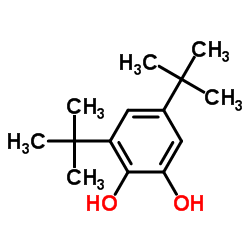3,5-Di-t-butylcatechol

3,5-Di-t-butylcatechol structure
|
Common Name | 3,5-Di-t-butylcatechol | ||
|---|---|---|---|---|
| CAS Number | 1020-31-1 | Molecular Weight | 222.323 | |
| Density | 1.0±0.1 g/cm3 | Boiling Point | 309.7±37.0 °C at 760 mmHg | |
| Molecular Formula | C14H22O2 | Melting Point | 95-100 °C(lit.) | |
| MSDS | Chinese USA | Flash Point | 136.5±21.1 °C | |
| Symbol |

GHS07 |
Signal Word | Warning | |
|
Catechol oxidase activity of a series of new dinuclear copper(II) complexes with 3,5-DTBC and TCC as substrates: syntheses, X-ray crystal structures, spectroscopic characterization of the adducts and kinetic studies.
Inorg. Chem. 47(16) , 7083-93, (2008) A series of dinuclear copper(II) complexes has been synthesized with the aim to investigate their applicability as potential structure and function models for the active site of catechol oxidase enzyme. They have been characterized by routine physicochemical ... |
|
|
3,5-Di-t-butyl catechol is a potent human ryanodine receptor 1 activator, not suitable for the diagnosis of malignant hyperthermia susceptibility.
Pharmacol. Res. 66(1) , 80-7, (2012) 3,5-Di-t-butyl catechol (DTCAT) releases Ca(2+) from rat skeletal muscle sarcoplasmic reticulum (SR) vesicles. Hence, it is a candidate for use as a substitute for halothane or caffeine in the in vitro contracture test for the diagnosis of susceptibility to m... |
|
|
A novel tripodal ligand containing three different N-heterocyclic donor functions and its application in catechol dioxygenase mimicking.
Chemistry 15(22) , 5567-76, (2009) We describe a novel chiral ligand, L, in which three different N-donor functions are linked to a methoxymethine unit: a methylpyrazole derivative, a methylimidazole unit, and a pyridyl residue. Complexes with FeCl(2), FeBr(2), and FeCl(3) have been synthesize... |
|
|
Chemistry of singlet oxygen--48. Isolation and structure of the primary product of photooxygenation of 3,5-di-t-butyl catechol.
Photochem. Photobiol. 46(3) , 325-30, (1987)
|
|
|
3,5-di-t-butylcatechol (DTCAT) as an activator of rat skeletal muscle ryanodine receptor Ca2+ channel (RyRC).
Biochem. Pharmacol. 69(3) , 485-91, (2005) In the present study, the effects of 3,5-di-t-butylcatechol (DTCAT) on ryanodine receptor Ca(2+) channel (RyRC) of skeletal muscle sarcoplasmic reticulum (SR) vesicles were investigated, both by monitoring extravesicular Ca(2+) concentration directly with the... |
|
|
Design and synthesis of new biomimetic materials.
J. Inorg. Biochem. 79(1-4) , 93-6, (2000) In this paper, it is reported that the histidine-silane derivative Boc-His(Boc)-CONH-(CH2)3Si(OEt)3 can be polymerized via the sol-gel method or can be grafted on a silica surface. The obtained organosilicas bear histidine molecules covalently bonded on the i... |
|
|
Synthesis, structure, redox properties and azide binding for a series of biphenyl-based Cu(II) complexes.
Dalton Trans. (24) , 2571-9, (2007) A series of biphenyl-based N(3)O ligands, 2, 4, 6, and 8 were synthesized and their Cu(II) complexes prepared. These complexes were characterized by a combination of elemental analysis, FAB-MS, UV-vis spectroscopy and electrochemistry. The structure of [Cu(N(... |
|
|
Synthesis, structure and catechol-oxidase activity of copper(II) complexes of 17-hydroxy-16-(N-3-oxo-prop-1-enyl)amino steroids.
Steroids 67(10) , 835-49, (2002) Copper is next to iron the most important element in the biological transport, storage and in redox reactions of dioxygen. A bioanalogous activation of dioxygen with copper complexes is used for catalytical epoxidation, allylic hydroxylation and oxidative cou... |
|
|
Effects of aminoacids on the autooxidation of 3,5-di-tert-butylcatechol in the presence of surface-active copper(II) complexes.
J. Colloid. Interface Sci. 255(2) , 425-7, (2002) The rate of autooxidation of 3,5-di-tert-butylcatechol (3,5-DTBC) in the presence of micelles formed from mixing equal concentrations of [Cu(C(12)-tmed)Br(2)] (where C(12)-tmed is N,N,N'-trimethyl-N'-dodecylethylenediamine) and several amino acids has been in... |
|
|
Mechanisms of the antispasmodic activity of 3,5-di-t-butyl catechol (DTCAT) on rat vascular smooth muscles.
Eur. J. Pharmacol. 561(1-3) , 112-20, (2007) In skeletal muscle sarcoplasmic reticulum vesicles, 3,5-di-t-butyl catechol (DTCAT) promotes the release of Ca(2+) through the activation of ryanodine receptor Ca(2+) channels. DTCAT mechanical and electrophysiological effects have now been investigated in ra... |